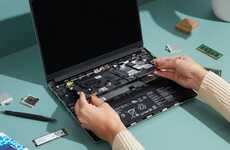
MIT's 'Self-Assembly Lab' is Reimagining the Manufacturing Industry
References: selfassemblylab.net & fastcodesign
MIT's 'Self-Assembly Lab' is a division of the world-renowned technological institute that is devoted to eliminating itself. The lab, run by Skylar Tibbits, is working on creating products and materials that create themselves. The Self-Assembly Lab has already created self-building furniture and self-tying shoes using special materials that rely on the innovations found in natural processes like DNA generation.
The lab's most recent product is taking on a competitive industry: tech. Specifically, it has created a prototype of a mobile phone that can assemble itself when agitated. More than just a phone with magnetic parts, the Self-Assembly Lab phones can have multiple parts dropped into a spinning vat, and, within minutes, the multiple phones will have assembled themselves, with the right piece for each phone falling into place.
The lab's most recent product is taking on a competitive industry: tech. Specifically, it has created a prototype of a mobile phone that can assemble itself when agitated. More than just a phone with magnetic parts, the Self-Assembly Lab phones can have multiple parts dropped into a spinning vat, and, within minutes, the multiple phones will have assembled themselves, with the right piece for each phone falling into place.
Trend Themes
1. Self-assembly Technology - The trend of self-assembly technology offers disruptive innovation opportunities by enabling the creation of products and materials that can autonomously build themselves.
2. Automated Manufacturing - The trend of automated manufacturing presents disruptive innovation opportunities by streamlining the production process and reducing labor costs through the use of self-assembly technology.
3. Efficient Product Assembly - The trend of efficient product assembly provides disruptive innovation opportunities by revolutionizing the way products are manufactured and assembled, saving time and resources.
Industry Implications
1. Electronics - The electronics industry can benefit from self-assembly technology by creating products that can assemble themselves, simplifying manufacturing processes.
2. Furniture - The furniture industry has the potential to be disrupted by self-assembly technology, allowing for easy and quick assembly of furniture pieces without the need for complex instructions or tools.
3. Footwear - The footwear industry can leverage self-assembly technology to create shoes that can self-tie or assemble, providing convenience and customization options for consumers.
4.5
Score
Popularity
Activity
Freshness























